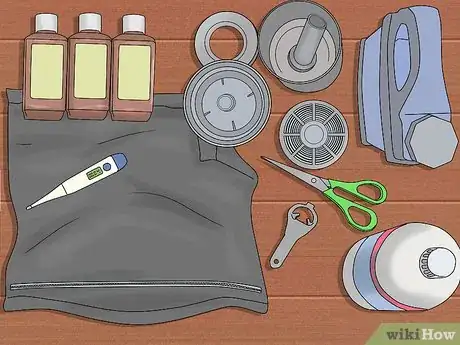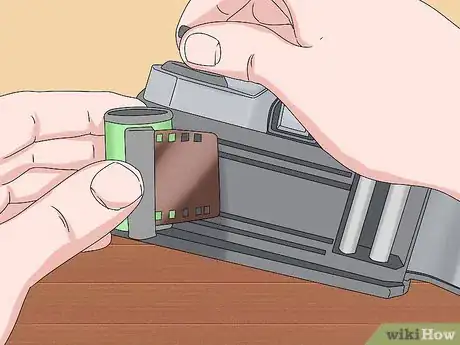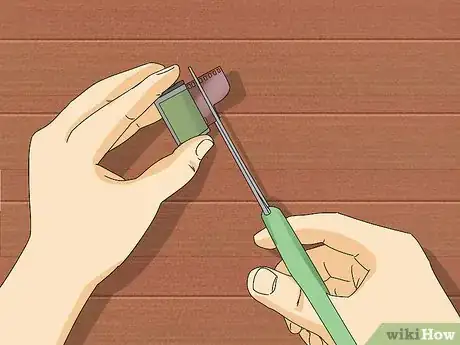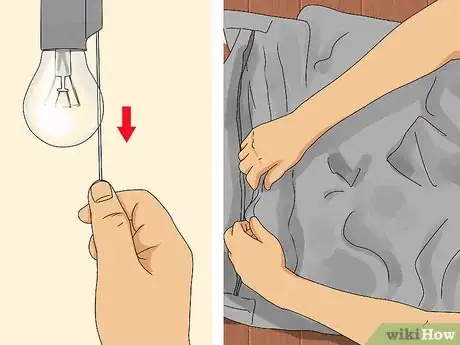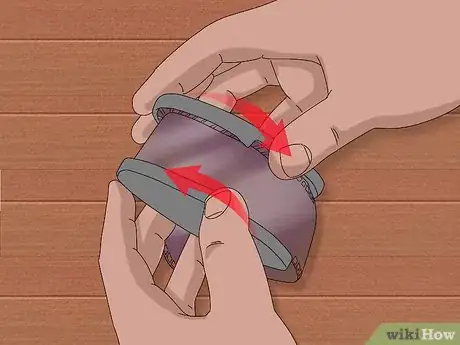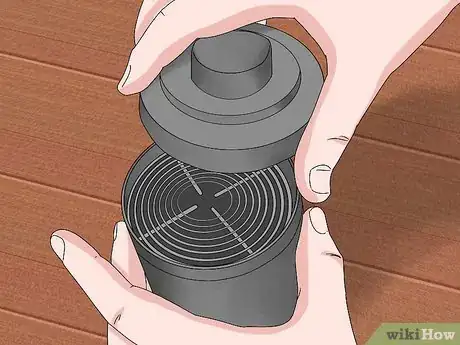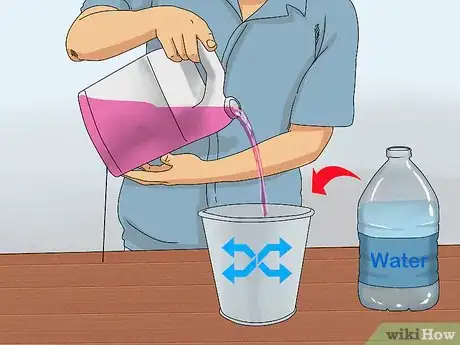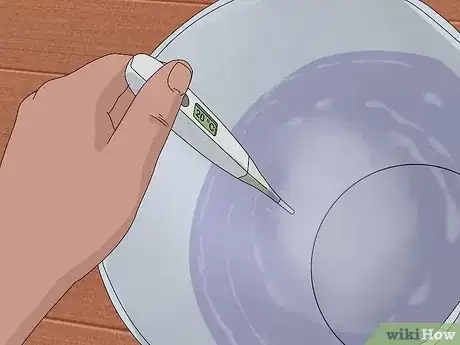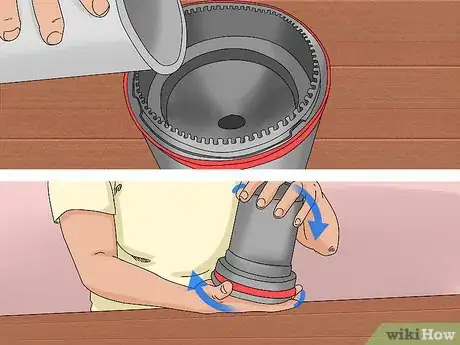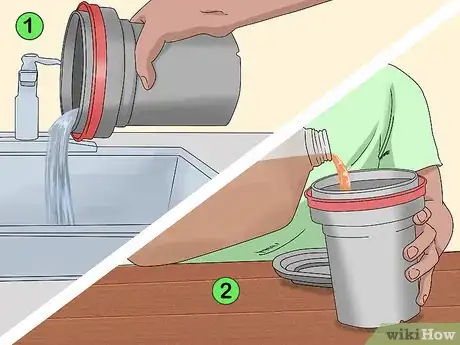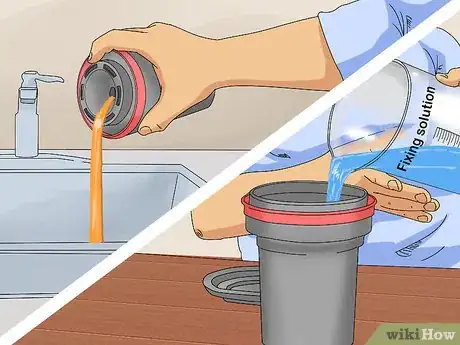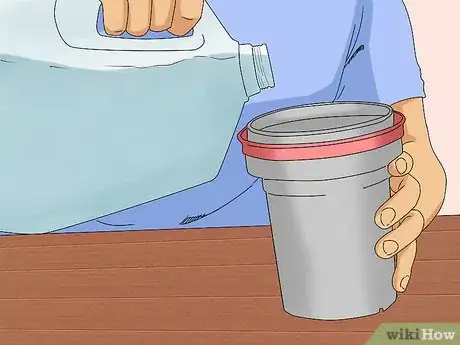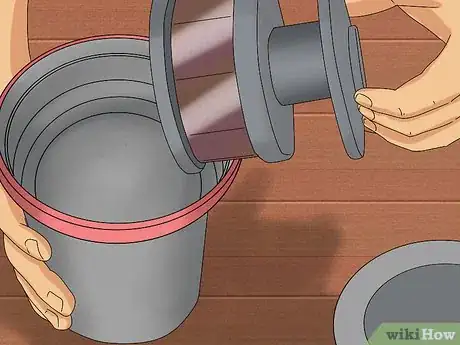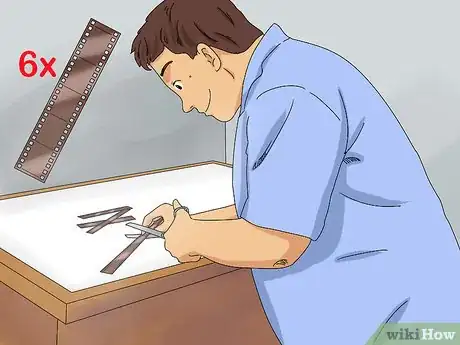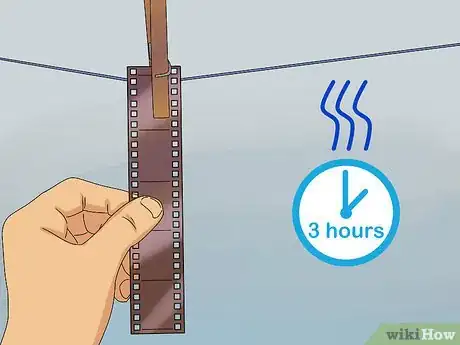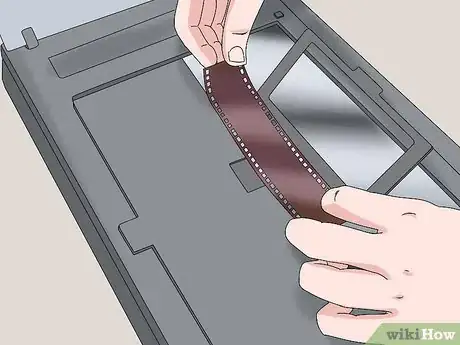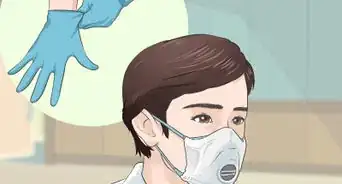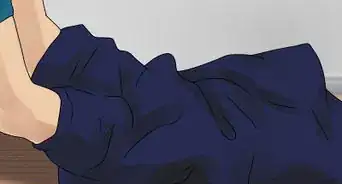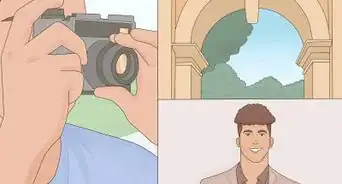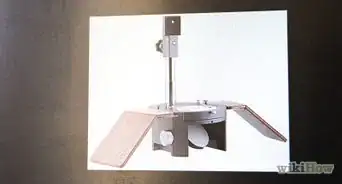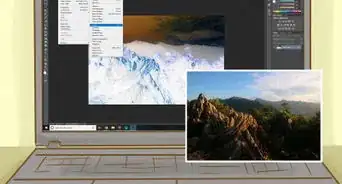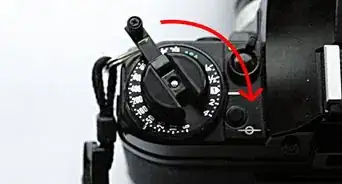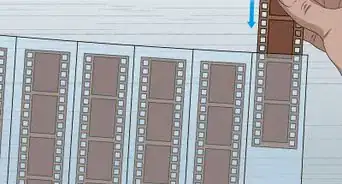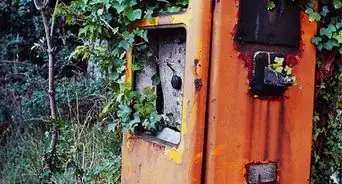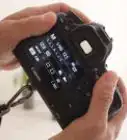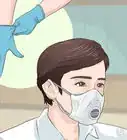X
This article was co-authored by Or Gozal, a trusted member of wikiHow's volunteer community. Or Gozal has been an amateur photographer since 2007. Her work has been published in, most notably, National Geographic and Stanford University's Leland Quarterly.
There are 9 references cited in this article, which can be found at the bottom of the page.
This article has been viewed 95,918 times.
Learn more...
Developing photos at home is a delicate and fun process that can be great for learning more about the process of photography. If you want to develop your own black and white photos at home, you can do so without a darkroom! When you’re developing photos, always be careful with the film because it’s very delicate.
Steps
Part 1
Part 1 of 4:
Setting Up
-
1Gather all of the necessary materials. In order to develop film at home, you’ll need a few items, including exposed film, a developing tank with reels, bottles for storing chemicals, a dark bag for loading the film into the reels, scissors, and a thermometer. For developing chemicals, you’ll need to purchase powder or liquid developer, premixed stop bath, and fixer.[1]
- If you’re using powdered chemicals, you should also plan to get at least 1 gallon (3.8 L) of distilled water. Tap water isn’t safe for the film and can cause the pictures to come out streaky.
- You can purchase all of the necessary equipment for developing film on the Internet from the few remaining film manufacturers, or a major seller like Amazon or eBay. If you’re lucky, you might be able to purchase some items from a local camera shop, if there’s one near you.
-
2Remove the exposed film from your camera. Once the film in the camera detaches from the right hand's spool, wind it just a bit to ensure that it doesn't fully retract into the canister and a little bit is left poking out. Then, open the film door and pop the canister out with your fingers. If the film does end up fully back inside the canister, you’ll need to use a tool to remove it.[2]
- To use double sided tape, stick a piece of tape to a strip of unexposed film, and roll it into the canister. Then, pull it out slowly to remove the lead of the film from the canister.[3]
- The film extractor is fairly simple to use. In most cases, the instructions for use are usually printed on the extractor and involve grasping the end of the lead with the extractor.
- The film canister opener acts as a bottle opener to pop off one end of the film canister. Only open the canister in total darkness, or the film will become ruined!
Advertisement -
3Cut the tab off of the end of the film for easier loading. Take a pair of scissors and cut off the tab at the end of the film, making a straight edge on the film. Round the corners with the scissors to make loading into the tank easier.[4]
- When you’re cutting, make sure you don’t cut too far into the first frame. This can damage the first picture on the reel!
Advertisement
Part 2
Part 2 of 4:
Loading the Film
-
1Turn off the lights or set up the dark bag. Make sure the room is pitch black, with no light coming in from windows, cracks in the door, or other light sources. If you’re having trouble finding a dark enough space, try using a windowless closet or bathroom.
- If you’re using a dark bag, follow the directions for the bag carefully to make sure no light gets into the bag. In that case, you don’t have to worry about turning off the lights, but you can still do so to ensure that your film doesn’t get ruined in case of an accident.
- You shouldn’t be able to see even a sliver of light. Keep your phone out of the room so the screen's brightness doesn’t affect the images.[5]
-
2Load the film onto the developing spool. Slide the free end of the film into the spool, and roll the spool back and forth in both directions to wrap the rest of the film around the spool. Once the film is completely loaded into the roll, use the scissors cut the canister off of the film.
- Ensure you only touch the film by the edges during this otherwise you can scratch your negatives.
- If this is your first time loading film, you may want to sacrifice a blank roll of film to practice in the light. Learning the mechanism for securing the film can be tricky, but a trial run can help.
-
3Place the reel on the center column and secure the funnel cap. The roll of film should be contained within the tank and completely protected from any light. Make sure you screw the cap on tightly to prevent any light from leaking in, and then turn the lights on.[6]
- Depending on the type of tank you’re using, you may need to push the reel onto the tank with a bit of force. In some cases, it will snap into place.
Advertisement
Part 3
Part 3 of 4:
Adding Chemicals
-
1Prepare your chemicals according to their directions if necessary. If you purchase powdered or undiluted chemicals, mix them with distilled water in the appropriate ratio, which will be labeled on the package. Then, set up all of your chemicals in the order that you’re going to use them.[7]
- Line up the developer, stop bath, and fixer in that order to make sure they’re ready for when you need them.
-
2Ensure that the chemicals are at the right temperature. For most brands of developer, the temperature should be around 68 °F (20 °C). Check the temperature of the chemical with your thermometer, and place the bottle in a bath of the appropriate temperature water if you need to raise or lower the temperature.
- If you’re diluting your developer, you can use hot or cold water to the adjust the temperature as necessary, which tends to be the faster of the 2 methods. However, if your chemicals are premixed, a water bath is the best way to change the temperature.
- All of the chemicals should be around the same temperature to prevent a sudden temperature change, which can shock the film and ruin the images.
-
3Add the developer into the top of the developing tank until it is full. Tap the tank on a table 2-3 times to dislodge any bubbles clinging to the film. Leave this to develop for the amount of time printed on the bottle, gently shaking the developing tank for 10 seconds every minute or so.[8]
- The more you shake the tank, the better the contrast of the image. If you want an image with less contrast, try shaking the tank for 15 seconds every 2 minutes.
-
4Pour the developer out of the tank and rinse the film with stop bath. Leave the stop bath in the tank for the amount of time printed on the bottle, inverting the tank a few times. Normally, stop bath will only need to be in the tank for a few minutes to remove the remaining developer from the film.
- The stop bath isn’t as time sensitive, so you can leave it in for additional time if necessary. Use this time to prepare your fixing solution if you haven’t already.
- Depending on the type of developer that you’re using, you may be able to pour it into a bottle for future use.
-
5Remove the stop bath and pour the fixing solution into the tank. Invert the tank for 30 seconds, and tap it on the table to remove any bubbles. Then, let the tank sit for the amount of time printed on the bottle of fixer before pouring it out.
- Most fixers are reusable, so you can pour the fixer into its original bottle for future use once the appropriate amount of time has elapsed.
-
6Rinse the film with distilled water to remove excess fixer. Sometimes, the fixer chemicals can cause bleaching on the lighter parts of the film if left on for too long. If you’re concerned about that, rinse the film in the tank with distilled water at 68 °F (20 °C) 2-3 times.
- Try to invert the tank at least 10-20 times during each rinse to ensure that the water coats all of the film.
Advertisement
Part 4
Part 4 of 4:
Handling the Negatives
-
1Open the tank and take out the film spool. Remove the cap of the tank and carefully pull the spool out. Untwist the spool until the film feeds out of the spool, and hold the negatives by the sides of the film to prevent fingerprints.[9]
- If you notice that the negatives on the strip are a pink or purple shade, they’re slightly underfixed. Place them back into the tank and pour fixer into the tank, repeating the fixing and rinsing process until they’re a lighter shade.
-
2Cut the film into manageable strips between frames. Your film will be pretty long, and you’ll need to hang it up to dry. Using scissors, slice the film into 6 to 12 in (15 to 30 cm) strips, being careful to cut between frames to avoid ruining a negative.[10]
- If you have a shorter roll of film, you may not need to cut it at all.
-
3Hang the negative strips to dry for at least 3 hours. In a well-ventilated and relatively dust-free area, such as a bathroom, find a place to hang up the film negatives. If you’re working in the bathroom, try attaching the strips to shower curtain rings with clothespins. Attach 1-2 clothespins to the bottom of each strip to weigh them down and prevent curling.[11]
- Let the film hang until it’s completely dry, and flatten the strips between the pages of a book if necessary.
- Alternatively, you can hang the strips from a string tied between 2 pieces of furniture to dry. Just be sure that the area is relatively free from dust and pet hair.
-
4Decide what you’d like to do with your prints. There are plenty of options for using your developed film, including making your own prints, scanning them onto your computer, purchasing prints, or purchasing scanned files. If you’re not sure how to proceed, visit a local camera store if there’s one nearby.[12]
- Scanning is a popular and easy option for most new photographers. With a bit of practice and equipment, you can scan images that are suitable for small prints and sharing on the Internet.
Advertisement
Community Q&A
-
QuestionWhy do developing rooms have red lights?
 Community AnswerRed lights have relatively low intensity, minimizing the chance of ruining the film while providing a little working light.
Community AnswerRed lights have relatively low intensity, minimizing the chance of ruining the film while providing a little working light. -
QuestionHow can I see in the dark room when developing pictures?
 Community AnswerWhen you roll your film onto the reel, you have to be in pitch darkness so the undeveloped film is not ruined. However, once it is rolled and in the light-proof tank, you can develop it in normal light. Just make sure not to open the tank until you have poured out your fixer.
Community AnswerWhen you roll your film onto the reel, you have to be in pitch darkness so the undeveloped film is not ruined. However, once it is rolled and in the light-proof tank, you can develop it in normal light. Just make sure not to open the tank until you have poured out your fixer.
Advertisement
Warnings
- Store the chemicals in a locked cabinet or drawer to prevent contamination or staining.⧼thumbs_response⧽
- Keep all of the developing items, including chemicals and equipment, away from children and pets.⧼thumbs_response⧽
Advertisement
Things You'll Need
- Exposed film
- Developing tank
- Thermometer
- Developing solution
- Stop bath
- Distilled water
- Fixing Solution (Fixer)
- Film extractor (optional)
- Scissors
- Timer/stopwatch
- Clothespins/film clips
References
- ↑ https://www.popsci.com/develop-black-and-white-film
- ↑ https://youtu.be/3ZrR8w8BhwQ?t=13
- ↑ https://www.lomography.com/magazine/75374-get-the-film-out-the-canister-without-a-film-puller
- ↑ https://www.popsci.com/develop-black-and-white-film#page-7
- ↑ Or Gozal. Photographer. Expert Interview. 20 March 2019.
- ↑ https://www.popsci.com/develop-black-and-white-film#page-8
- ↑ https://www.popsci.com/develop-black-and-white-film#page-9
- ↑ https://www.popsci.com/develop-black-and-white-film#page-9
- ↑ https://www.popsci.com/develop-black-and-white-film#page-10
About This Article
Advertisement
